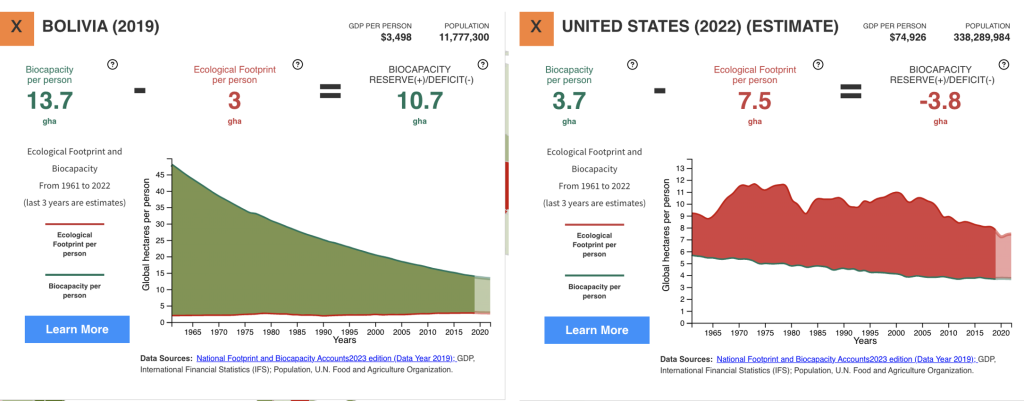By Nilam Bedi, PhD, ESRAG Cadre Liaison to The Rotary Foundation

Dr. Nilam Bedi
The accelerating impacts of climate change are driving increasingly urgent calls to action, with the goal of sustainable living at their core. Sustainability means living within the limits of the planet to regenerate itself in the face of mounting human demands upon its resources. Our human demands are multi-dimensional, stressing the limits of land, forests, water, biodiversity, and the atmosphere. Within this broad framing, understanding our carbon footprint and our ecological footprint are both important.
More and more people realize our situation has evolved from seeing “climate change” as a distant concern to witnessing an ever-growing succession of current climate disasters like the 2022 floods in Pakistan and this summer’s wildfires across Canada. We’re now in climate emergency. The data and analytical frameworks shared here help identify effective choices to restore balance between human consumption and planetary capacity. In this article I also share examples of how this approach is being successfully used by nations (Switzerland) and cities (Kamikatsu, Japan).
Individual calculators, such as those provided by the Global Footprint Network and the World Wildlife Fund help you understand the environmental impact of your lifestyle. These tools can also be used proactively to see how changes in individual behaviors can lead to aggregate improvements.
Historically, the discussion on sustainable living tended to be couched in terms of voluntary acts by those concerned about the environment. Scaling up individual actions across populations has remained a challenge. But now – with the increasing recognition that climate change is an existential danger to all of us – collective action by communities, business, and national and international policy makers is picking up momentum.
“People act with focus and determination when they know their action is existentially critical for them,” writes sustainability expert, Mathis Wackernagel, winner of an array of international environmental awards and President of the Global Footprint Network. In his article “From Noble to Necessary: how Global Footprint Network approaches sustainability communication,” he adds “when actors – whether individuals, companies, or cities…grasp that their active participation in sustainability solutions is central to their own existence and to their wellbeing, they become unstoppable. This is called having ‘skin in the game.’”
Modeling national impacts and policy options: The Global Footprint Network, in association with York University and the Footprint Data Foundation, has developed massive amounts of information and tools. Since 2003, Global Footprint Network has been maintaining and publishing online National Footprint and Biocapacity Accounts which track emissions and the capacity of biosystems to absorb them. These accounts function like a budget report, showing which countries are living within their planetary means and which are exceeding them. They cover all countries from 1961 to today, based on UN statistics. The latest accounts document that humanity’s total demand now exceeds what the planet can absorb by over 60%.
Here are graphs from the data for Bolivia and the United States.

Source: Global Footprint Network’s National Footprint and Biocapacity Accounts
Many countries are using such data and tools to develop their policies to address climate change. Here’s an example from the Swiss Federal Office for the Environment. In June, Swiss citizens approved a new climate law to reduce fossil fuel use and reach net-zero emissions by 2050.
Tools for cities: Cities generate an estimated 70% of greenhouse gas emissions, but have traditionally lacked the information and analytical tools to tackle this problem successfully. But now the World Bank has developed an urban climate action planning tool called CURB in partnership with the C40 Cities Climate Leadership Group, Global Covenant of Mayors, and AECOM Consulting.
Already being used by more than 100 cities around the world, CURB equips cities to plan across six sectors in an integrated way: private buildings, municipal buildings and public lighting, electricity generation, solid waste, transportation, and water and wastewater. Cities are using CURB to compare the cost, energy, and climate impact of different technological and policy solutions so they can select the most cost-effective investments that are feasible for their context.
C40 offers interactive dashboards and analytical tools to estimate emissions from various categories of consumption – including locally-produced and imported goods – and provides an implementation guide to reduce the city’s footprint. This short, multilingual video explains the importance of measuring emissions at the city level. These data and analytical tools help cities develop and refine climate action plans, set informed targets, and acquire project financing.
This case study of Kamikatsu illustrates how data and analysis can power enormous progress. In the 1990’s Kamikatsu became the Japanese community to commit to becoming a Zero-Waste Town. Monitoring its data intensively, the community encouraged its residents to change their buying, consuming, and waste management practices. The transformation is astonishing. Until 1997, this town used incineration as its main method of waste management. Now, residents separate waste in 45 categories. They have achieved a recycling rate of over 80%, well above the national average of 20%. Here’s an overview of how they do it. This program would not necessarily be feasible in all settings, but the example of Kamikatsu does highlight the level of commitment needed to address the climate emergency.
Thus, while much of the publicity about the crisis is on the global level, changing behaviors at the city and national levels is crucial to mitigating climate change. This is a perfect fit for Rotarians, who organize their civic service through local clubs and our regional networks: Districts and Zones. We can leverage the trust and relationships we have built through Rotary’s long history of local and international humanitarian service to catalyze collaboration on climate solutions. The resources I’ve shared in this article will help you zero in on the data and analyses needed to understand the big picture and to shape effective action.
Nilam Bedi, an economist who consults worldwide on sustainable development planning, is Past President of the Toronto Eglinton Rotary Club, chairs District 7070’s Environmental Action Committee ,and serves as an Assistant District Governor. He is active on the international aspects of Rotary as a member of the Cadre of Technical Experts.

